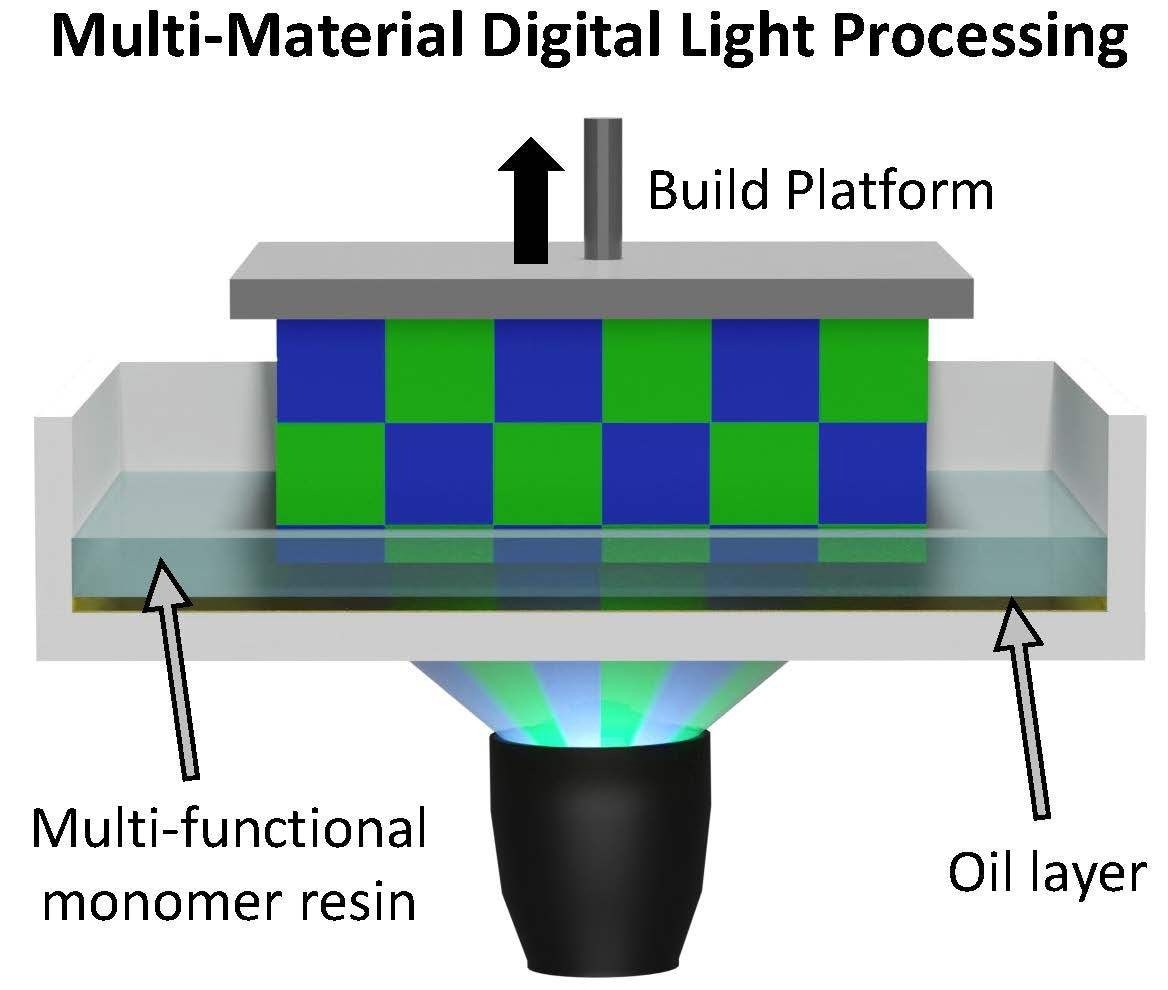The US National Science Foundation (NSF) is in search of materials that “revolutionize and engineer our future.”
 This illustration shows a single resin producing two materials with different properties during light-based 3D printing. Image Credit: Adarsh Krishnamurthy.
This illustration shows a single resin producing two materials with different properties during light-based 3D printing. Image Credit: Adarsh Krishnamurthy.
Scientists at Iowa State University and the University of California, Santa Barbara believe they can achieve this by making fundamental alterations to Digital Light Processing, a form of 3D printing that utilizes light rather than heat to rapidly solidify and solidify liquid resin into plastic layers.
These modifications aim to enable the capability for multi-material printing.
We want to produce two material properties with the same resin. That’s revolutionary in terms of materials for 3D printing.
Adarsh Krishnamurthy, Associate Professor, Mechanical Engineering, Iowa State University
Adarsh Krishnamurthy is the leader of the project.
These researchers are leveraging their proficiency in materials chemistry, computational science, machine learning, and materials characterization to identify resins that, when subjected to various light wavelengths, will harden with distinct properties.
Consequently, with a single material, Digital Light Processing 3D printers could manufacture items with rigid and flexible regions, opening up a new realm of possibilities for multi-material 3D printing.
New Materials for National Needs
This project is one of 37 initiatives that the National Science Foundation (NSF) unveiled in September, constituting a four-year investment totaling $72.5 million to “create novel materials to address grand societal challenges and develop the scientific and engineering workforce of tomorrow.”
This endeavor is aligned with the federal, multi-agency Materials Genome Initiative, which is dedicated to accelerating the advancement of materials discovery and application.
By integrating numerous research disciplines across NSF as well as federal and industrial partnerships, this program truly revolutionizes the design, discovery, and development of new materials for addressing urgent national needs.
Sethuraman Panchanathan, Director, National Science Foundation
Under this program, Iowa State researchers secured an $800,000 grant to leverage artificial intelligence and machine learning algorithms for the purpose of creating novel resins that can be 3D printed with diverse properties.
Krishnamurthy explained that the team's proficiency in machine learning tools will prove invaluable in their ability to efficiently assess various options and promptly identify potential materials for this innovative approach.
The program has allocated $1.1 million to UCSB researchers for their involvement in the project. Under the leadership of Michael Chabinyc, a Materials Professor, the UCSB researchers will primarily concentrate on polymer chemistry.
Krishnamurthy explained that the combined efforts of Iowa State and UCSB researchers will be directed toward creating specialized biomedical platforms. These platforms will feature structured surfaces with differing levels of stiffness, aiming to encourage and guide the growth of cell cultures.
Presently, these cultures are typically cultivated on rigid glass or a pliable silicon polymer.
But that’s not how the body is. The body has both – hard bone and soft tissue. The different stiffnesses promote better cell growth.
Adarsh Krishnamurthy, Associate Professor, Mechanical Engineering, Iowa State University
Computing Material Improvements
Apart from the physical printing and testing of materials, researchers will create a "digital twin" of the system. This digital twin can simulate and predict how various resins react to different light wavelengths and exposure conditions.
Machine learning tools will play a crucial role in streamlining the research process by reducing the list of potential resins for study and development, saving time and effort.
Additionally, the researchers will employ a machine learning technique known as reinforcement learning. This technique will ensure that progress in experiments and theories leads to overall advancements in multi-material, light-based 3D printing, enhancing the efficiency and effectiveness of their research.
The extensive application of computational science assists the Iowa State-UCSB team in making substantial strides toward fulfilling the objectives of the Materials Genome Initiative “discovering, manufacturing, and deploying advanced materials twice as fast and at a fraction of the cost compared to traditional methods.”